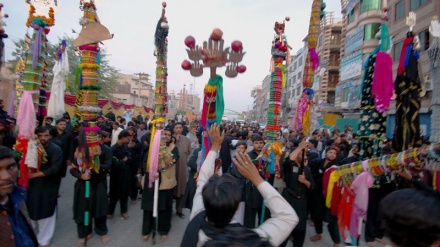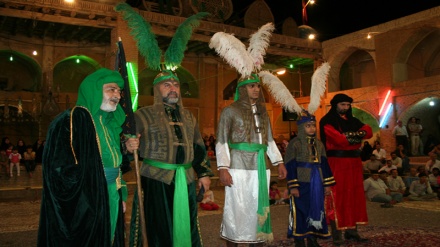Muharram mourning traditions in different lands - 11
In this series, which delves into the various mourning traditions associated with the Immortal Epic of Ashura in various lands, we look at the earliest history of mourning for Imam Husain (AS).
We continue from where we left you yesterday, and before continuing our discussion on Majalis-e Aza or Mourning Assemblies in Iran in the post-Buwaiyhid period, let us cast a glance on Egypt and see how the tragedy of Karbala impacted that ancient land, where several shrines of the descendants of the Prophet are located. In the book "an Nujoum az-Zaherah fi Mulouk al-Misar wa’l Qaherah", it is written that as early as 174 AH the people used to commemorate the martyrdom of Imam Husain (AS) despite the repressive policies of the Abbasid regime.
Over a century later, these gatherings of Aza al-Husain gradually became public during the time of the Ikhshid Turkic dynasty. In 358 AH, when the Fatemids of North Africa extended their control over Egypt and established Cairo as their capital, Majales al-Aza flourished and increased far beyond what they had been in the past. The commemoration of the tragedy of Karbala became official ceremonies and one of the cultural events of the Fatemid Empire that extended all over North Africa, the Mediterranean island of Sicily, Syria and the Hejaz in Arabia.
One of the most important academic institutions in Cairo was Dar al-Hikmah or House of Wisdom, where Majales al-Aza were held in the month of Muharram. The historian Miqrezi has transmitted details, as to how Muharram was observed during the era of Moiz le-Din-Allah. He has mentioned that crowds of devotees gathered at the shrines of Sayyedah Kulsoum and Seyyedah Nafisa. Mourners showed their grief and performed Maatam or rhythmical beating of chests to the chant of elegies. Groups of mourners included solders as well.
Ibn Mamoun has mentioned in the book "Nusous min Akhbaar Misar" that in the year 515 AH on the day of Ashura, at the residence of Dai Afzal a wide and special Sofrah-Dastar Khawn was spread. Cheese, pickles, vinegar and bread of barley were served. The ministers and commanders attended the congregation. The Majlis began with the recitation of the holy Qur’an, and after the end of the ceremony food was served, followed by syrup of dates.
On the day of Ashura, the Fatemid Caliph, Aamer-Billah gave audience to the people at the gate of his palace. He sat on a mat, made of grass, along with the Chief Minister and members of the judiciary, courtiers and other notables. All were bare footed and wore no turbans. At the precise time, after the elegies, a Dastar-Khawn was spread out, and later money was distributed among the reciters of the holy Qur’an, preachers, and poets who discussed the merits of the Prophet’s Ahl al-Bayt.
Historians have also mentioned that on the eve of Ashura, the Wazeer or Chief Minister would visit the Jame’ al-Juyushi Mosque, where dignitaries and scholars were present, and they would all pass the night in prayer and worship. In the morning they again gathered, where the Fatemid Caliph sat on a simple sheet of cloth. On his face, sorrow and grief was visible.
On the Day of Ashura in the early morning hours, it was also the habit of the Fatemid Caliph to put on mourning dress and visit, along with his retinue and the Chief Qazi, the Mashhad al-Husain Mosque, where it is claimed the sacred head of Imam Husain (AS) was brought from Damascus and buried. Prior to this practice, such gatherings were arranged in the famous Jame’ al-Azhar, named after “Zahra” the epithet of the Prophet’s noble daughter, Hazrat Fatema (peace upon her).
The Majlis started with recitation of the holy Qur’an and then poets recited elegies of the Martyrs of Karbala. This Majlis lasted more than three hours. After this, the people went to the Caliph’s palace, where simple mats were spread instead of fine carpets. After recitation of the holy Qur’an, poets and scholars dwelt on the tragedy of Karbala. Then the Dastar-Khawn was arranged, filled with pots of black lentils, halwa, pickle, cheese, milk, honey, and bread.
Afterwards people returned to their homes and group of preachers visited different parts of the city and narrated tragic events of Karbala in poetic form. Business remained closed on the day of Ashura. Here we relate an interesting event recorded by Qazi Nu’man in the book "al-Majalis wa’l-Musa'eraat". The Qazi says since the day after Ashura that year happened to be Friday he decided to dwell on the tragedy of Karbala in his Friday Prayer sermons so as to enlighten the masses and remove superstitious practices including false statements attributed to the Prophet which mischievous people have innovated for the 10th of Moharram by wrongly celebrating it as a day of Eid as was the custom of Jews on this day. He continues that he discussed the matter with the Fatemid Caliph, Moiz, saying that God has surely honoured Imam Husain (AS) by decreeing his martyrdom on the Day of Ashura, similarly to His honouring of the Commander of the Faithful, Imam Ali ibn Abi Taleb (AS) by decreeing the grand nights of the month of blessed Ramadhan for his martyrdom.
In his reply, the Caliph instructed the Qazi to enlighten the people with the truth from the Ahl al-Bayt, saying: Nu’man, you know the ignorant, how much they respect the Day of Ashura, but for reasons other than that, which Allah has glorified it. They have wrongly turned Ashura into a day of celebration and festivities, due to the mischief of the Ommayads, who accustomed them to it. So explain to them the reasons that Ashura should be observed with reverence. For example tell them: O creation of Allah! You should hold this day in high esteem as Allah has exalted it, and follow the Sunnah of your Prophet in respecting it. So do not celebrate it as a day of rejoicing and merriment, as was celebrated by the foes of Allah and followers of the Satan, that is the children of Marwan. Ashura should be observed by attending the Majales al-Aza, and through the shedding of tears.
Unfortunately, when the Kurdish warlord, Salahuddin Ayyoubi, betrayed the trust placed in him by the Fatemid caliph by seizing the reins of power as Wazeer, and then overthrowing the Shi’ite Muslim dynasty, he destroyed libraries, burned the books, persecuted the followers of the Ahl al-Bayt, and imposed Sunni rule and practices, similar to what the Christians had done in Islamic Spain. Today, although Ashura may not be a public holiday or mourning for the martyrs of Karbala not publicly commemorated on the streets of Egyptian cities, most of the people of Egypt, whatever their school of jurisprudence, still have reverence for the Prophet’s Ahl al-Bayt.
They visit the shrines of the Prophet’s descendants, and the 3-million-plus Shi’ite Muslims of Egypt do observe the mourning ceremonies in their houses or community halls, a tradition they have kept alive. The same policy of persecution of the Shi’ite Muslims was followed by the Ayyubids in Greater Syria, where Azadari almost disappeared from Damascus, Aleppo and Mosul, with only a few pockets left, like Lebanon and the mountainous parts of Syria.
The Mamluks and after them the Ottomans followed the same repressive policies. Thus the only areas where Majales al-Aza flourished were Iraq and Iran, where after the establishment of the Safavid Dynasty in 1501, these commemorative gatherings of the tragedy of Karbala became widespread, and were soon taken to the subcontinent, where especially in the Deccan or southern Peninsular India, they became very popular under the rule of the Qutb-Shahi, Adel-Shahi, and Nizam-Shahi dynasties.
EA/AS/SS


